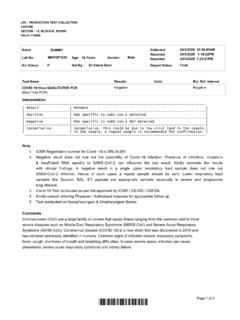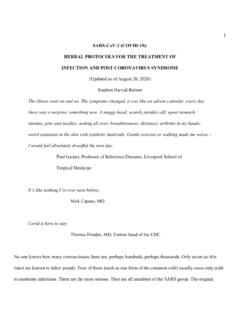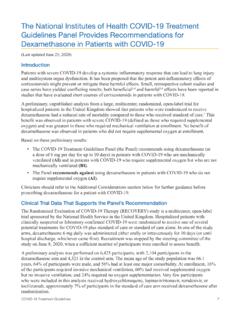Transcription of COVID‑19 STRATEGY UPDATE - World Health Organization
1 14 April 2020 COVID 19 STRATEGY UPDATE World Health Organization 2020 Some rights reserved. This work is available under the Creative Commons Attribution-NonCommercialShareAlike IGO licence (CC BY-NC-SA IGO; )Under the terms of this licence, you may copy, redistribute and adapt the work for non-commercial purposes, provided the work is appropriately cited, as indicated below. In any use of this work, there should be no suggestion that WHO endorses any specific Organization , products or services. The use of the WHO logo is not permitted. If you adapt the work, then you must license your work under the same or equivalent Creative Commons licence. If you create a translation of this work, you should add the following disclaimer along with the suggested citation: This translation was not created by the World Health Organization (WHO).
2 WHO is not responsible for the content or accuracy of this translation. The original English edition shall be the binding and authentic edition .Any mediation relating to disputes arising under the licence shall be conducted in accordance with the mediation rules of the World Intellectual Property designations employed and the presentation of the material in this publication do not imply the expression of any opinion whatsoever on the part of WHO concerning the legal status of any country, territory, city or area or of its authorities, or concerning the delimitation of its frontiers or boundaries. Dotted and dashed lines on maps represent approximate border lines for which there may not yet be full agreement. The mention of specific companies or of certain manufacturers products does not imply that they are endorsed or recommended by WHO in preference to others of a similar nature that are not mentioned.
3 Errors and omissions excepted, the names of proprietary products are distinguished by initial capital letters. All reasonable precautions have been taken by WHO to verify the information contained in this publication. However, the published material is being distributed without warranty of any kind, either expressed or implied. The responsibility for the interpretation and use of the material lies with the reader. In no event shall WHO be liable for damages arising from its in Geneva, photo: April 2020 COVID-19 STRATEGY UPDATEO vercoming COVID 19It has now been more than 100 days since WHO was notified of the first cases of what we now call COVID 19, and much has changed since we launched the first Strategic Preparedness and Response Plan two months of 13 April, more than million people have been infected, and almost 85 000 people have lost their lives.
4 WHO grieves with all families who have lost a loved one, and salutes Health workers all over the World who have put themselves in harm s way every day to save global spread of the virus has overwhelmed Health systems, and caused widespread social and economic disruption. By putting societies and economies on hold, we have curtailed the ability of the virus to spread through our communities. These defensive measures have helped to limit some of the short-term impacts of the virus, and bought us time to translate what we have learned about the virus into solutions so that we can get back to a more normal way of living: a new normal. We have learned so much about this virus, and we re still learning. This STRATEGY UPDATE is based on the evidence the World has accumulated in the past three months about how COVID-19 spreads, the severity of disease it causes, how to treat it, and how to stop of the main things we ve learned is that the faster all cases are found, tested and isolated, the harder we make it for this virus to spread.
5 This principle will save lives and mitigate the economic impact of the document guides the public Health response to COVID-19 at national and subnational levels, including practical guidance for strategic action, tailored to the local context. This pandemic is much more than a Health crisis. It requires a whole-of-government and whole-of-society response. The resolve and sacrifice of frontline Health workers must be matched by every individual and every political leader to put in place the measures to end the re all in this together, and we will only succeed together. There is no time to waste. WHO s singular focus is on working to serve all people to save lives and stop the Tedros Adhanom Ghebreyesus WHO Director GeneralFOREWORD214 April 2020 COVID-19 STRATEGY UPDATEThe coronavirus disease 2019 (COVID 19) pandemic is exacting a huge toll on individuals, families, communities, and societies across the World .
6 Daily lives have been profoundly changed, economies have fallen into recession, and many of the traditional social, economic, and public Health safety nets that many people rely on in times of hardship have been put under unprecedented strain. ABOUT THIS Studio1 For the Strategic Preparedness and Response Plan see: For the Global Humanitarian Response Plan see: just a short time, a localised outbreak of COVID-19 evolved into a global pandemic with three defining characteristics: Speed and scale: the disease has spread quickly to all corners of the World , and its capacity for explosive spread has overwhelmed even the most resilient Health systems (figure 1). Severity: overall 20% of cases are severe or critical, with a crude clinical case fatality rate currently of over 3%, increasing in older age groups and in those with certain underlying conditions.
7 Societal and economic disruption: shocks to Health and social care systems and measures taken to control transmission have had broad and deep socio-economic document is intended to help guide the public Health response to COVID-19 at national and subnational levels, and to UPDATE the global STRATEGY to respond to the COVID-19 pandemic. This document complements, and provides links to, the technical guidance published by WHO on preparing for and responding to COVID-19 since the beginning of the response. It translates knowledge accumulated since the publication of the Strategic Preparedness and Response Plan (SPRP)1 on 3 February 2020, into additional practical guidance for whole-of-government and whole-of-society strategic action that can be adapted according to specific national and subnational situations and capacities.
8 This STRATEGY UPDATE provides guidance for countries preparing for a phased transition from widespread transmission to a steady state of low-level or no transmission. This UPDATE also highlights the coordinated support that is required from the international community to meet the challenge of COVID-19: it complements plans (including the Global Humanitarian Response Plan)2 that specifically address the issues of COVID-19 response in humanitarian and fragile settings, and plans currently under development that will address the broader social and economic impacts of April 2020 COVID-19 STRATEGY UPDATECURRENT SITUATION AND KEY INSIGHTSCOVID 19 is a new disease, distinct from other diseases caused by coronaviruses, such as Severe Acute respiratory syndrome (SARS) and middle east respiratory syndrome (MERS).
9 The virus spreads rapidly, and outbreaks can grow at an exponential rate. At present, there are no therapeutics or vaccines proven to treat or prevent COVID 19, although national governments, WHO and partners are working urgently to coordinate the rapid development of medical According to data from countries affected early in the pandemic, about 40% of cases will experience mild disease, 40% will experience moderate disease including pneumonia, 15% of cases will experience severe disease, and 5% of cases will have critical disease. The crude mortality rate varies substantially by country depending on the populations affected, the point a country is at in the trajectory of its outbreak, and the availability and application of testing (countries that only test hospitalized cases will have a higher reported crude mortality rate than countries with more widespread testing).
10 The crude clinical case fatality is currently over 3%, increasing with age and rising to approximately 15% or higher in patients over 80 years of age. Morbidity associated with COVID-19 is also very high. Underlying Health conditions that affect the cardiovascular, respiratory , and immune systems confer an increased risk of severe illness and death. Countries are at different stages of national and subnational outbreaks. Where there has been early action and implementation of comprehensive public Health measures such as rapid case identification, rapid testing and isolation of cases, comprehensive contact tracing and quarantine of contacts countries and subnational regions have suppressed the spread of COVID-19 below the threshold at which Health systems become unable to prevent excess mortality.













